Origami cat creation is an enjoyable and engaging craft that transforms a simple square paper into a charming feline figure. With the following instructions from solcat.net, you’ll discover the simple steps, tips, and creative ideas to enhance your origami journey and create unique paper cats. This will appeal to cat lovers and origami enthusiasts alike.
1. What Is Origami Cat and Why Should I Make One?
Origami cat is the art of folding paper into the shape of a cat, and you should make one because it is a fun, accessible, and rewarding activity for all ages. Origami, originating from Japan, combines artistry and mathematics to create intricate sculptures. Crafting an origami cat offers numerous benefits, blending the joy of creativity with the satisfaction of producing a delightful piece of art.
- Creative Expression: Origami provides a canvas for self-expression, allowing you to experiment with different papers, colors, and embellishments to create unique cat designs.
- Mindfulness and Relaxation: The repetitive folding motions can be meditative, helping to reduce stress and improve focus.
- Cognitive Benefits: Following instructions and visualizing the final form enhances spatial reasoning and problem-solving skills.
- Accessibility: Origami requires minimal materials—just paper and your hands—making it an affordable and accessible hobby for anyone.
- Connection with Felines: For cat lovers, creating origami cats can be a heartwarming way to celebrate their affection for these animals.
2. What Do I Need To Prepare Before Making an Origami Cat?
Before embarking on your origami cat-making adventure, gather these essential materials to ensure a smooth and enjoyable crafting experience:
- Origami Paper: Start with standard origami paper, which is thin and easy to fold. Size options include 6×6 inch or 8×8 inch squares. Experiment with different colors and patterns to add personality to your origami cat.
- Flat Surface: Choose a clean, flat surface to work on. A table or desk provides stability and prevents unwanted creases.
- Instructions: Whether you follow a book, video, or online guide, clear instructions are crucial. For beginners, visual aids like diagrams or videos can be particularly helpful. Websites like solcat.net offer easy-to-follow tutorials tailored for various skill levels.
- Pencil and Eraser: Use a pencil to lightly mark fold lines if needed. An eraser helps correct any mistakes without damaging the paper.
- Ruler or Bone Folder: A ruler or bone folder can create sharp, precise creases, which are essential for a neat origami model.
- Optional Embellishments: Consider adding details like eyes, whiskers, or a nose with markers, stickers, or small pieces of colored paper to personalize your origami cat.
3. What Are the 5 Search Intentions of “How to Do an Origami Cat”?
Understanding the search intentions behind “How To Do An Origami Cat” is crucial for providing relevant and engaging content. Here are five key search intentions:
- Step-by-Step Instructions: Users seek detailed, easy-to-follow instructions, often with visual aids, to create a basic origami cat.
- Easy Origami Cat Models for Beginners: Many searchers are new to origami and want simple designs that are quick to learn.
- Advanced Origami Cat Tutorials: Experienced origami enthusiasts look for complex, challenging cat models that require more intricate folding techniques.
- Origami Cat Variations: Users want to explore different styles and designs, such as origami cat faces, full-body cats, or specific poses.
- Educational Purposes: Parents, teachers, or hobbyists may search for origami cat tutorials for educational activities, crafting sessions, or to teach children basic origami skills.
4. How to Make an Easy Origami Cat Face: A Step-by-Step Guide
Follow these steps to create an adorable origami cat face. Each step is designed to be simple and clear, perfect for beginners.
4.1. Step 1: Start with the Back of the Paper
Place your origami paper on a flat surface with the back side (usually white) facing up. This ensures that the colored side will be on the outside of your finished cat face.
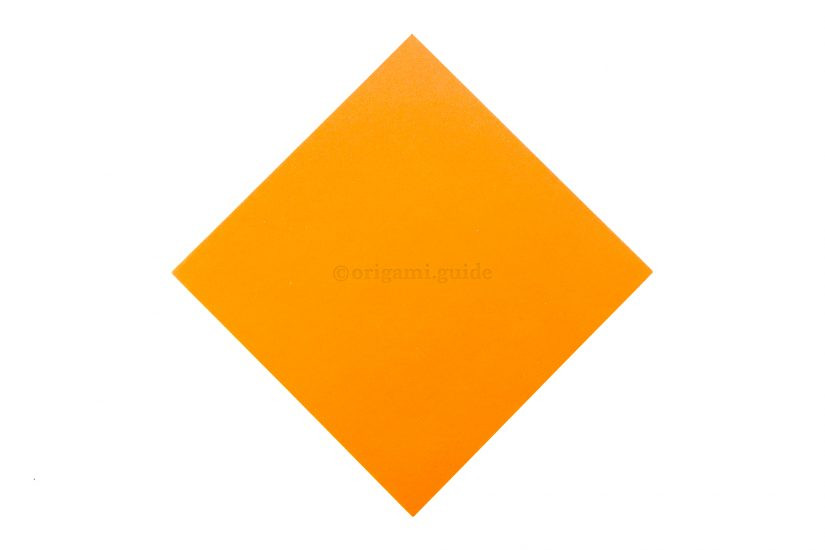 The back side of the origami paper, typically white, facing upwards on a flat surface
The back side of the origami paper, typically white, facing upwards on a flat surface
4.2. Step 2: Fold the Bottom Corner to the Top Corner
Fold the bottom corner of the paper up to meet the top corner, forming a triangle. Crease the fold firmly to create a sharp line. This will be the base shape for your origami cat face.
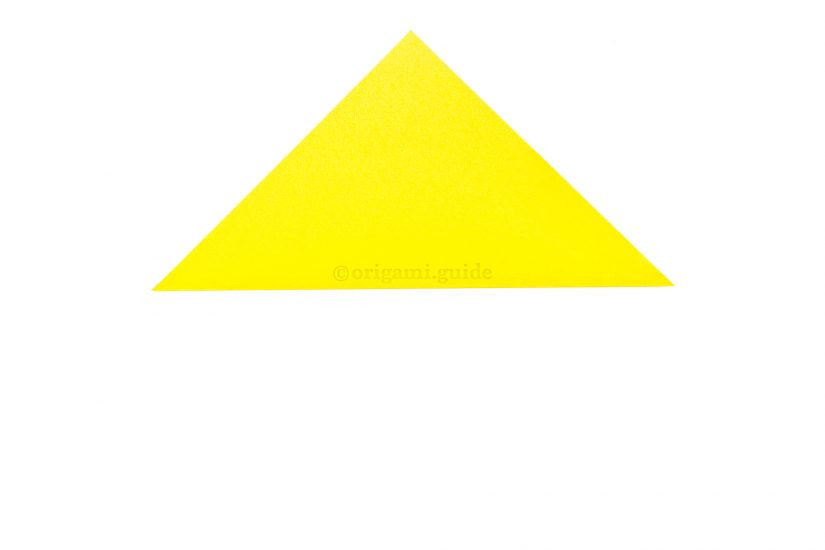 Folding the bottom corner to the top corner to form a triangle for the origami cat face
Folding the bottom corner to the top corner to form a triangle for the origami cat face
4.3. Step 3: Mark the Middle
Take the right corner of the triangle and bring it over to the left corner. Make a small crease along the bottom edge to mark the middle point. This mark will help you align the ears in the next steps.
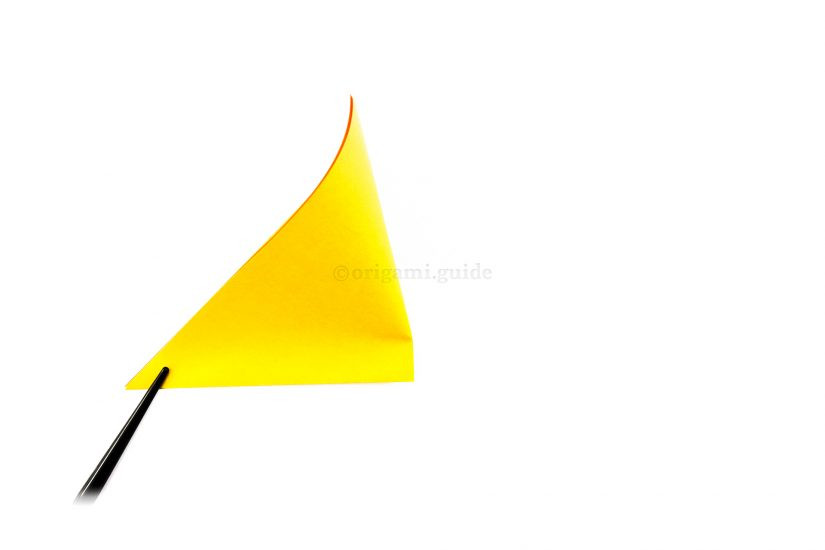 Marking the middle point of the bottom edge of the triangle by folding the right corner to the left corner
Marking the middle point of the bottom edge of the triangle by folding the right corner to the left corner
4.4. Step 4: Unfold
Unfold the previous step to return the paper to the triangle shape. You should now see a small crease at the midpoint of the bottom edge.
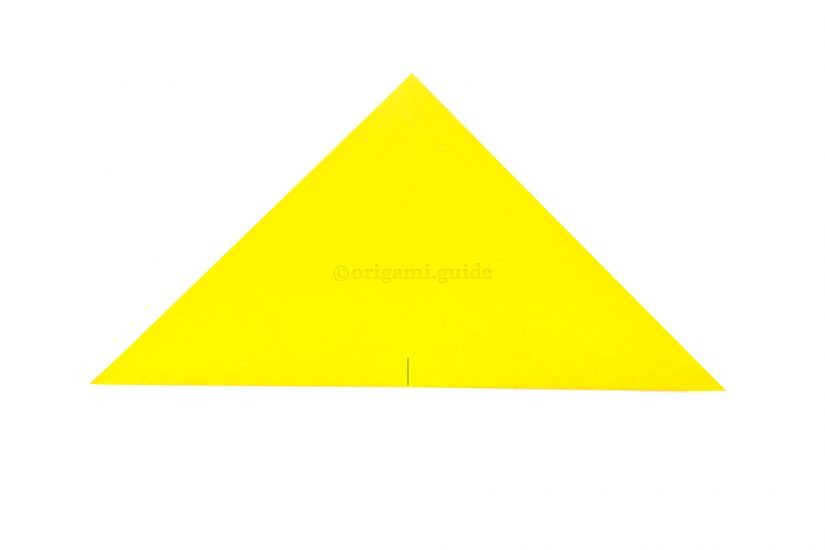 Unfolding the triangle to reveal the marked middle point on the bottom edge
Unfolding the triangle to reveal the marked middle point on the bottom edge
4.5. Step 5: Create the Right Ear
Take the right corner and fold it upwards and to the right at an angle away from the top point. This forms one of the cat’s ears. The angle and size of the fold will determine the shape of the ear.
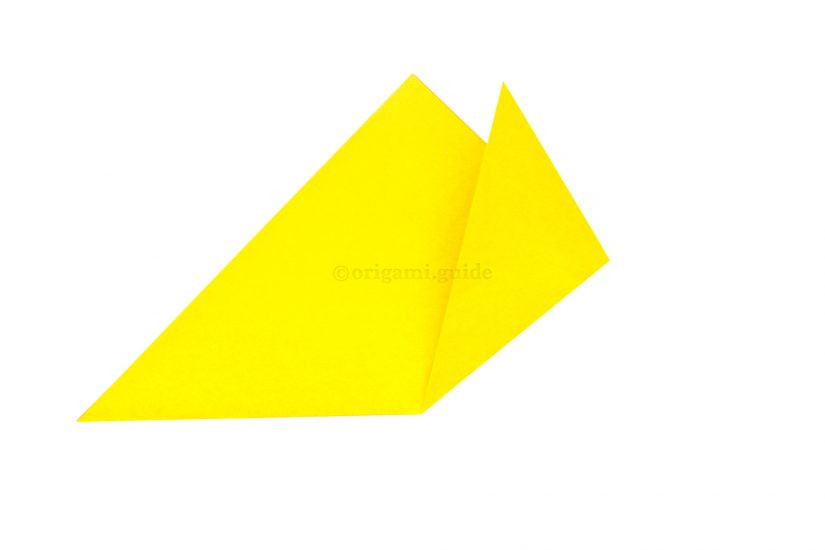 Folding the right corner upwards and to the right to create one of the cat's ears
Folding the right corner upwards and to the right to create one of the cat's ears
4.6. Step 6: Create the Left Ear
Repeat the same process on the left side. Fold the left corner upwards and to the left at an angle, trying to match the angle and size of the right ear. Symmetry is key to a balanced cat face.
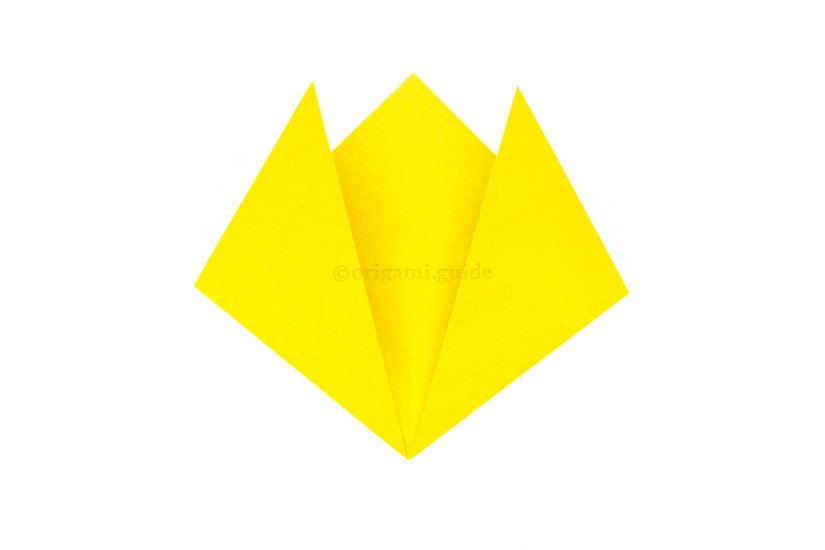 Folding the left corner upwards and to the left to create the second cat ear, matching the first
Folding the left corner upwards and to the left to create the second cat ear, matching the first
4.7. Step 7: Form the Chin
Fold the bottom point upwards slightly to create the cat’s chin. This softens the sharp point and gives the face a more rounded, feline appearance.
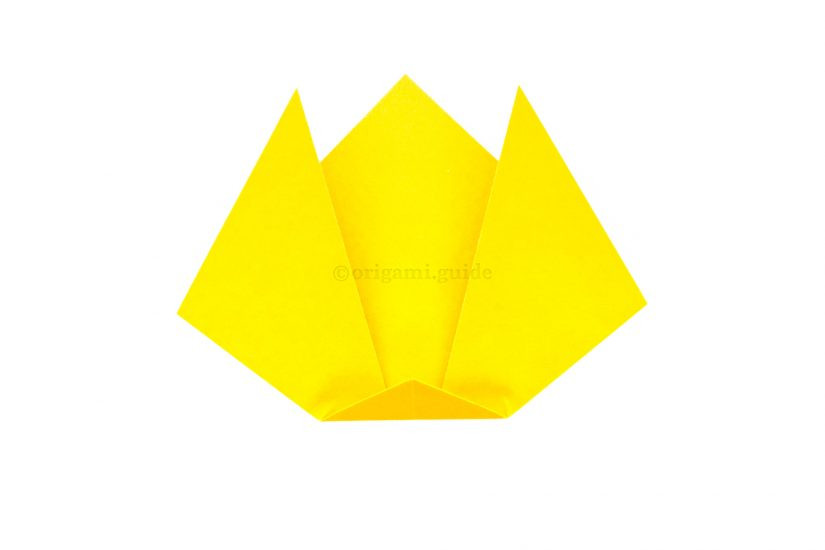 Folding the bottom point upwards to create the cat's chin
Folding the bottom point upwards to create the cat's chin
4.8. Step 8: Flip Over
Flip the origami cat face over to the other side. You now have a completed origami cat face. Use markers or pens to add details like eyes, a nose, and whiskers to bring your cat to life.
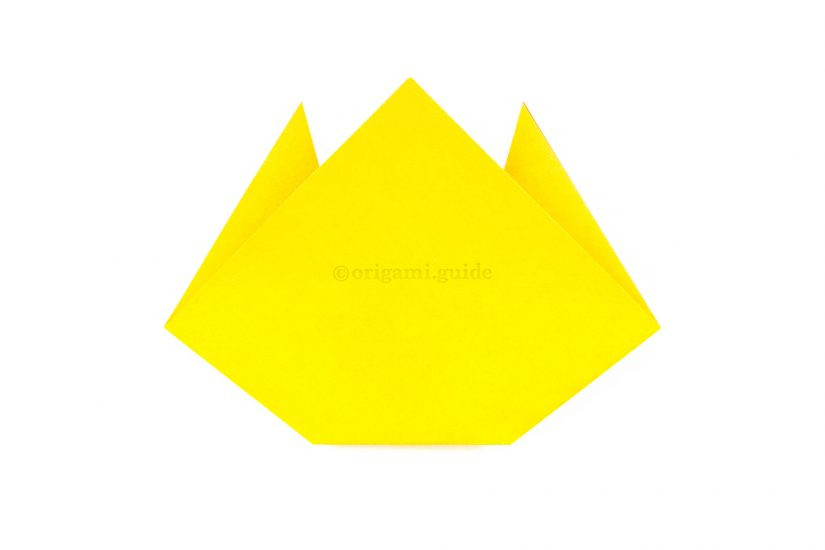 Flipping the origami cat face over to reveal the completed model
Flipping the origami cat face over to reveal the completed model
5. What Are Creative Ideas To Decorate Your Origami Cat?
Once you’ve mastered the basic origami cat, explore these creative decorating ideas to personalize your creations:
- Drawing: Use fine-tipped markers or pens to draw intricate patterns, stripes, or spots on your origami cat. This is a great way to mimic different cat breeds or create whimsical designs.
- Painting: Acrylic paints or watercolors can add vibrant colors and textures to your origami cat. Consider using metallic or glitter paints for a glamorous touch.
- Adding Accessories: Glue on tiny accessories like bows, ribbons, or miniature hats to dress up your origami cat.
- Using Patterned Paper: Instead of plain paper, choose origami paper with pre-printed patterns, such as floral designs, geometric shapes, or cat-themed motifs.
- Creating a Cat Family: Fold multiple origami cats in different sizes and colors to create a charming cat family. Arrange them in a display or use them as decorations for a cat-themed party.
- Making Origami Cat Bookmarks: Glue your origami cat onto a sturdy piece of cardstock to create a unique bookmark. This is a thoughtful gift for book-loving cat enthusiasts.
6. What Are Tips and Tricks for Perfecting Your Origami Cat?
To achieve flawless origami cat creations, consider these expert tips and tricks:
- Start Simple: Begin with basic origami cat models and gradually progress to more complex designs. This builds your confidence and skills.
- Practice Makes Perfect: The more you fold, the better you’ll become. Don’t be discouraged by initial mistakes; each attempt enhances your technique.
- Use Sharp Creases: Precise, sharp creases are essential for a neat and professional-looking origami model. Use a bone folder or ruler to reinforce your folds.
- Choose the Right Paper: Opt for thin, high-quality origami paper that is easy to fold and holds its shape well. Avoid using thick paper, which can be difficult to work with.
- Follow Instructions Carefully: Pay close attention to each step in the instructions and double-check your folds to ensure accuracy.
- Watch Video Tutorials: Video tutorials can provide a clearer understanding of complex folding techniques. Websites like solcat.net offer a variety of helpful origami tutorials.
- Experiment with Colors and Patterns: Don’t be afraid to experiment with different colors and patterns to create unique and eye-catching origami cats.
- Incorporate Personal Touches: Add your own creative embellishments, such as hand-drawn details or accessories, to personalize your origami cat.
7. Why Is Origami Good for Cats and Humans?
Origami offers numerous benefits for both cats and humans, enhancing creativity, cognitive skills, and emotional well-being.
7.1. Benefits for Humans
- Cognitive Development: Origami stimulates spatial reasoning, problem-solving skills, and memory. Following instructions and visualizing the final form enhances cognitive abilities.
- Stress Reduction: The repetitive folding motions can be meditative, helping to reduce stress and promote relaxation.
- Creative Expression: Origami provides an outlet for self-expression, allowing you to experiment with different designs, colors, and embellishments.
- Fine Motor Skills: Folding intricate origami models improves hand-eye coordination and fine motor skills, which is particularly beneficial for children and seniors.
- Educational Tool: Origami can be used in educational settings to teach geometry, math concepts, and spatial awareness in a fun and engaging way.
- Mindfulness and Focus: The concentration required for origami can enhance mindfulness and improve focus, helping you stay present in the moment.
7.2. Benefits for Cats
While cats can’t fold origami themselves, they can benefit from the activity in several indirect ways:
- Stimulation: Cats are naturally curious and enjoy exploring new objects. An origami cat can serve as a novel toy, providing mental and physical stimulation.
- Play: Cats can bat, chase, and pounce on origami cats, turning them into interactive playthings. Always supervise your cat during play to ensure they don’t ingest any paper.
- Bonding: Creating origami cats for your feline friend can strengthen your bond. Your cat will appreciate the attention and the new toy.
- Safe Entertainment: Origami cats, made from non-toxic paper, can be a safe alternative to commercial cat toys that may contain harmful chemicals.
- Enrichment: Introducing new and interesting objects like origami cats can enrich your cat’s environment, preventing boredom and promoting overall well-being.
8. What Are Other Origami Models Besides Cats?
Besides cats, the world of origami offers a vast array of models to explore. Each category provides unique challenges and creative opportunities.
- Animals: From graceful cranes to playful dogs, origami animals are a favorite among folders. These models capture the essence of various creatures in paper form.
- Flowers: Origami flowers, such as roses, tulips, and lilies, make beautiful decorations and gifts. These models require delicate folding techniques to mimic the intricate details of real flowers.
- Geometric Shapes: Explore the mathematical side of origami with geometric shapes like stars, cubes, and pyramids. These models often involve modular origami, where multiple pieces are folded and assembled to create a larger structure.
- Boxes: Origami boxes are practical and decorative, perfect for storing small items or giving gifts. These models can range from simple square boxes to intricate lidded containers.
- Vehicles: Create miniature cars, boats, and airplanes with origami vehicle models. These are popular among children and offer a fun way to learn about different modes of transportation.
- Holiday Decorations: Celebrate special occasions with origami holiday decorations, such as Christmas trees, snowflakes, and Easter bunnies. These models add a festive touch to any home.
9. How Does Origami Relate to Cat Care?
While origami and cat care might seem unrelated, they share common ground in creativity, mindfulness, and providing enrichment for your feline friend. Here’s how origami can enhance your approach to cat care:
- Creating Cat Toys: Origami can be used to create safe and engaging toys for your cat. Simple origami shapes, like balls or small animals, can provide hours of entertainment.
- Mindful Interaction: Engaging in origami while spending time with your cat can foster a sense of mindfulness and connection. The calming nature of origami can create a relaxing atmosphere for both you and your pet.
- Personalized Environment: Use origami to create personalized decorations for your cat’s space. Origami flowers or geometric shapes can add a touch of artistry to their environment.
- Gift-Giving: Origami cats make thoughtful and unique gifts for fellow cat lovers. These handmade creations show your care and appreciation for their passion.
- Educational Opportunities: Origami can be used to teach children about cat breeds, anatomy, and care. Folding different origami cat models can be a fun and interactive way to learn.
10. Frequently Asked Questions (FAQ) About How to Do an Origami Cat
10.1. What kind of paper is best for making origami cats?
The best paper for origami cats is thin, high-quality origami paper. It should be easy to fold and hold its shape well. Standard origami paper, available in 6×6 inch or 8×8 inch squares, is ideal for beginners.
10.2. Can children make origami cats?
Yes, children can make origami cats with supervision. Start with simple models and provide clear, step-by-step instructions. Origami is a great way to enhance their fine motor skills and creativity.
10.3. How do I make my origami cat more durable?
To make your origami cat more durable, use thicker paper or apply a thin layer of clear glue or sealant after folding. This will help it withstand handling and play.
10.4. What can I do with my finished origami cats?
You can use your finished origami cats as decorations, toys, bookmarks, or gifts. Get creative and incorporate them into various crafts and displays.
10.5. Where can I find more origami tutorials?
You can find more origami tutorials on websites like solcat.net, which offers a variety of easy-to-follow guides and videos for all skill levels.
10.6. How do I prevent my origami paper from tearing?
To prevent your origami paper from tearing, fold gently and avoid using excessive force. Sharp creases are important, but don’t over-crease the paper.
10.7. Can I use regular printer paper for origami?
While you can use regular printer paper for origami, it is not ideal. Printer paper is thicker and more prone to tearing than origami paper. It is best to use thinner, specialized origami paper for better results.
10.8. How do I add details to my origami cat?
You can add details to your origami cat using fine-tipped markers, pens, stickers, or small pieces of colored paper. Draw eyes, noses, whiskers, and patterns to personalize your creation.
10.9. Is origami a good activity for stress relief?
Yes, origami is a great activity for stress relief. The repetitive folding motions can be meditative, helping to reduce stress and promote relaxation.
10.10. What are some variations of the origami cat design?
Some variations of the origami cat design include origami cat faces, full-body cats, sitting cats, and cats with different ear and tail styles. Experiment with different designs to find your favorite.
Explore the delightful world of origami cats and discover the joy of creating these charming paper felines. Whether you’re a beginner or an experienced origami enthusiast, there’s always something new to learn and create. Visit solcat.net for more origami tutorials, cat care tips, and a vibrant community of cat lovers. Dive into a wealth of articles, captivating images, and engaging videos that celebrate the wonderful world of cats.
Address: 950 Alaskan Way, Seattle, WA 98104, United States.
Phone: +1 (206) 386-4000.
Website: solcat.net.
